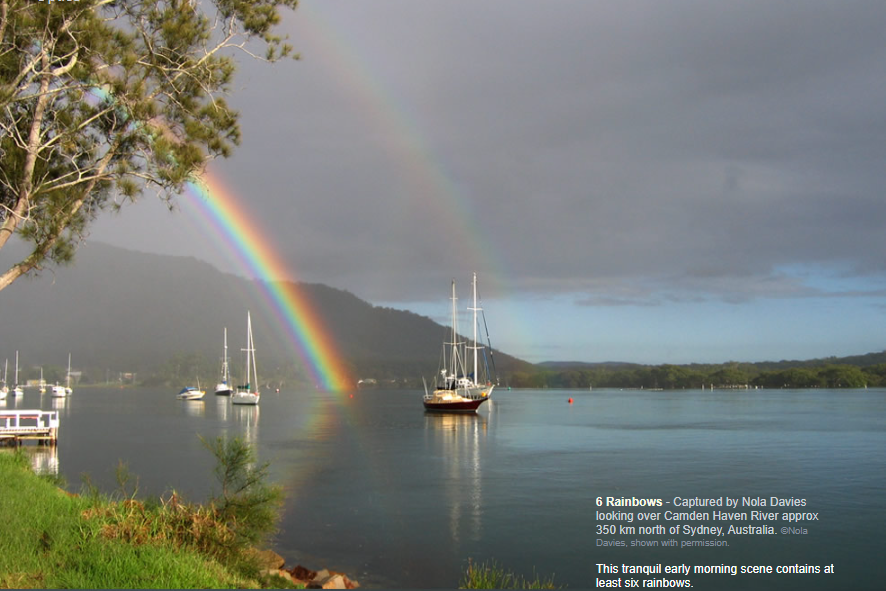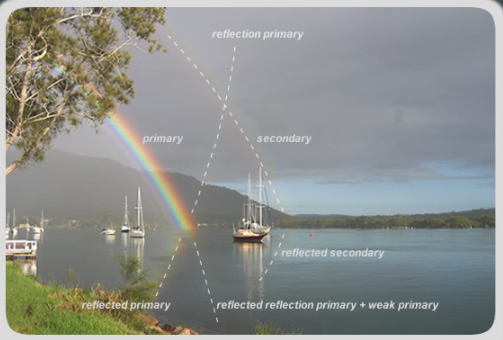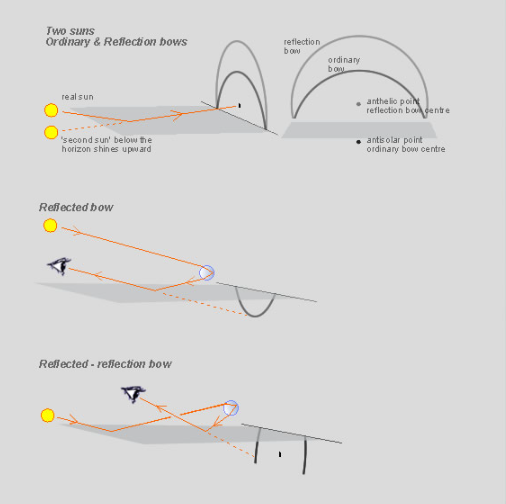6 Bows
The Mystery of 6 Bows: Unveiling the Enchanting World of Atmospheric Optics
Have you ever witnessed the captivating sight of rainbows gracing the sky? Rainbows have a way of filling our hearts with wonder and joy. But did you know that sometimes, not one or two, but six rainbows can appear in a single scene? Yes, it's true! Let's dive into the intriguing phenomenon of 6 bows and explore the magic that lies within.
The Primary Rainbow and its Supernumeraries
When we think of rainbows, the primary rainbow is usually the first image that comes to mind. It is the most vibrant and well-known of the bunch. In addition to the primary rainbow, there are also secondary rainbows that exhibit inverted colors. But what lies between them? Amidst this atmospheric spectacle, we can find a faint yet enchanting bow known as the reflection bow. However, understanding the terminology of rainbow nomenclature, including reflection and reflected bows, can be quite perplexing.
The Reflection Bow: A Mirage of Light
Ever wondered how a reflection bow comes into existence? When sunlight reflects off a body of water and travels upwards, it creates a reflection bow. To raindrops, this reflected light appears as if it emanates from a second sun, positioned at the same angular distance below the water's surface as the real sun is above it. This "second sun" forms a rainbow centered on a point opposite in the sky called the anthelic point. The reflection bow intersects with the ordinary primary at the horizon and gracefully curves above it in the sky.
Secondary Bows: Unveiling Hidden Reflection Rainbows
But wait, there's more! Secondary bows also play a role in creating reflection rainbows. In the image captured between two yachts and a red buoy, we can catch a glimpse of a faint trace of a secondary bow producing a reflection rainbow. These bows add an extra layer of enchantment to the atmospheric display, showcasing the intricate interplay of light and water droplets.
Bows Beneath the Horizon: A Reflection of Reflections
While the bows that appear below the horizon may initially seem like reflections, they are not true reflections in the traditional sense. Unlike their sky-bound counterparts, these bows are formed by different raindrops. Known as reflected bows, they are created when rays of light pass through raindrops and then reflect off the water's surface. This reflection inverts the rainbow, causing the bow's center to be positioned above the horizon at the anthelic point. The reflected bow and its corresponding ordinary bow meet at a cusp on the horizon, resulting in a mesmerizing spectacle.
The Intricacies of Reflected-Reflection Primary Bows
One of the most captivating aspects of atmospheric optics is the complex path that light takes to create these awe-inspiring phenomena. The reflected-reflection primary bow below the horizon is formed through a tortuous ray path. Sunlight reflects off the water's surface, traveling upwards until it encounters raindrops that form rainbow rays. These rays then reflect once again off the water, ultimately reaching our eyes. The primary bow follows a similar path, resulting in the superimposition of the two bows. By observing the intensity and how it diminishes with distance from the horizon, we can gain insights into the relative contributions of both bows to the overall display.
The Enigma of 6 Bows: A Blend of Reflection and Refraction
As we delve deeper into the realm of 6 bows, we encounter a perplexing blend of reflection and refraction. The interplay between sunlight, water droplets, and our vantage point creates a symphony of light that dances across the sky. While the primary bow continues its journey, the reflected bow adds its unique touch to the spectacle, casting an ethereal glow upon the horizon. The extent to which each bow contributes to the overall display may vary, creating a dynamic and ever-changing visual experience.
Unveiling Nature's Artistry
Nature has an incredible way of painting breathtaking masterpieces in the sky. The occurrence of 6 bows serves as a reminder of the intricate beauty and complexity that lies within atmospheric optics. Each bow tells a unique story, showcasing the interplay of light, water, and the world around us. So, the next time you find yourself gazing at a rainbow-filled sky, take a moment to appreciate the hidden wonders that may unfold before your eyes.

6 Rainbows - Captured by Nola Davies looking over Camden Haven River approx 350 km north of Sydney, Australia. ©Nola Davies, shown with permission.
This tranquil early morning scene contains at least six rainbows.
The bright primary with its supernumeraries and secondary with inverted colours are obvious.
Between them is a faint 'reflection bow'. (Rainbow nomenclature with its 'reflection and reflected bows is not easy!)
Three more bows appear below the horizon in front of the water.

Reflection primary
Sunlight reflected off the water and traveling upwards makes the reflection bow. To raindrops, the reflected light appears to come from a second sun the same angular distance below the water as the real sun is above it.
The 'second sun' forms a rainbow centered on a point opposite in the sky called the 'anthelic point'. The reflection bow intersects the ordinary primary at the horizon and curves above it in the sky.
Secondary bows also produce reflection rainbows and there is a trace of one in the image between the two yachts and the red buoy.

Bows in front of the water
The bows below the horizon are not reflections in the true sense. Rainbows do not exist as real objects and therefore do not have reflections. The bows beneath the horizon are formed by different raindrops from the ones that formed the sky bows. They are called reflected bows.
Reflected bows are made by rays that are reflected by the water surface after they have passed through raindrops. The reflection inverts the rainbow and the bow centre is then above the horizon at the anthelic point. The reflected bow and the corresponding ordinary bow meet in a cusp at the horizon.
The reflected - reflection primary bow below the horizon is formed by a tortuous ray path. Sunlight reflects off the water and travels upwards. It then meets raindrops which form rainbow rays. These reflect again off the water into the eye.
The continuation of the primary follows the same path and the two bows are superimposed. The intensity of the reflected bow and the extent to which the suspected 'reflected-reflection' bow's intensity falls off with distance from the horizon give some clues as to its contribution relative to a pure continuation of the primary. A rapid fall off for an observer close to the ground or sea surface suggests a primary bow continuation. Here there is probably a contribution from both bows.
Note: this article has been automatically converted from the old site and may not appear as intended. You can find the original article here.
Reference Atmospheric Optics
If you use any of the definitions, information, or data presented on Atmospheric Optics, please copy the link or reference below to properly credit us as the reference source. Thank you!
-
<a href="https://atoptics.co.uk/blog/6-bows/">6 Bows</a>
-
"6 Bows". Atmospheric Optics. Accessed on April 18, 2024. https://atoptics.co.uk/blog/6-bows/.
-
"6 Bows". Atmospheric Optics, https://atoptics.co.uk/blog/6-bows/. Accessed 18 April, 2024
-
6 Bows. Atmospheric Optics. Retrieved from https://atoptics.co.uk/blog/6-bows/.